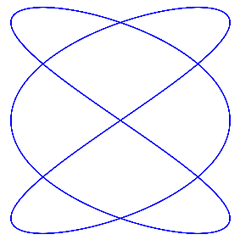Lissajous figure
A Lissajous figure is a plane curve traced by a point moving in two simple harmonic motions that are at right angles to each other. The simplest Lissajous figures are circles or ellipses, but they can also take the form of lemniscates and other, more complex shapes. They can be most easily be formed by supplying different alternating voltages to the x- and y-deflection plates of an oscilloscope. Only if the frequencies are commensurable will a true Lissajous figure (i.e., a closed curve) be formed.
 |
| A Lissajous figure.
|
They are named for the French scientist Jules Antoine Lissajous (1822–1880), who experimented with them in the 1850s, and are also known as Bowditch curves, because they had been written about earlier by the American astronomer and mathematician Nathanial Bowditch (1773–1838).
Lissajous orbit
A Lissajous orbit is a periodic orbit in which there is a combination of planar and vertical components. An object in a Lissajous orbit can follow around a Lagrangian point of a three-body system without requiring any propulsion. Compare with Lyapunov orbit and halo orbit.


